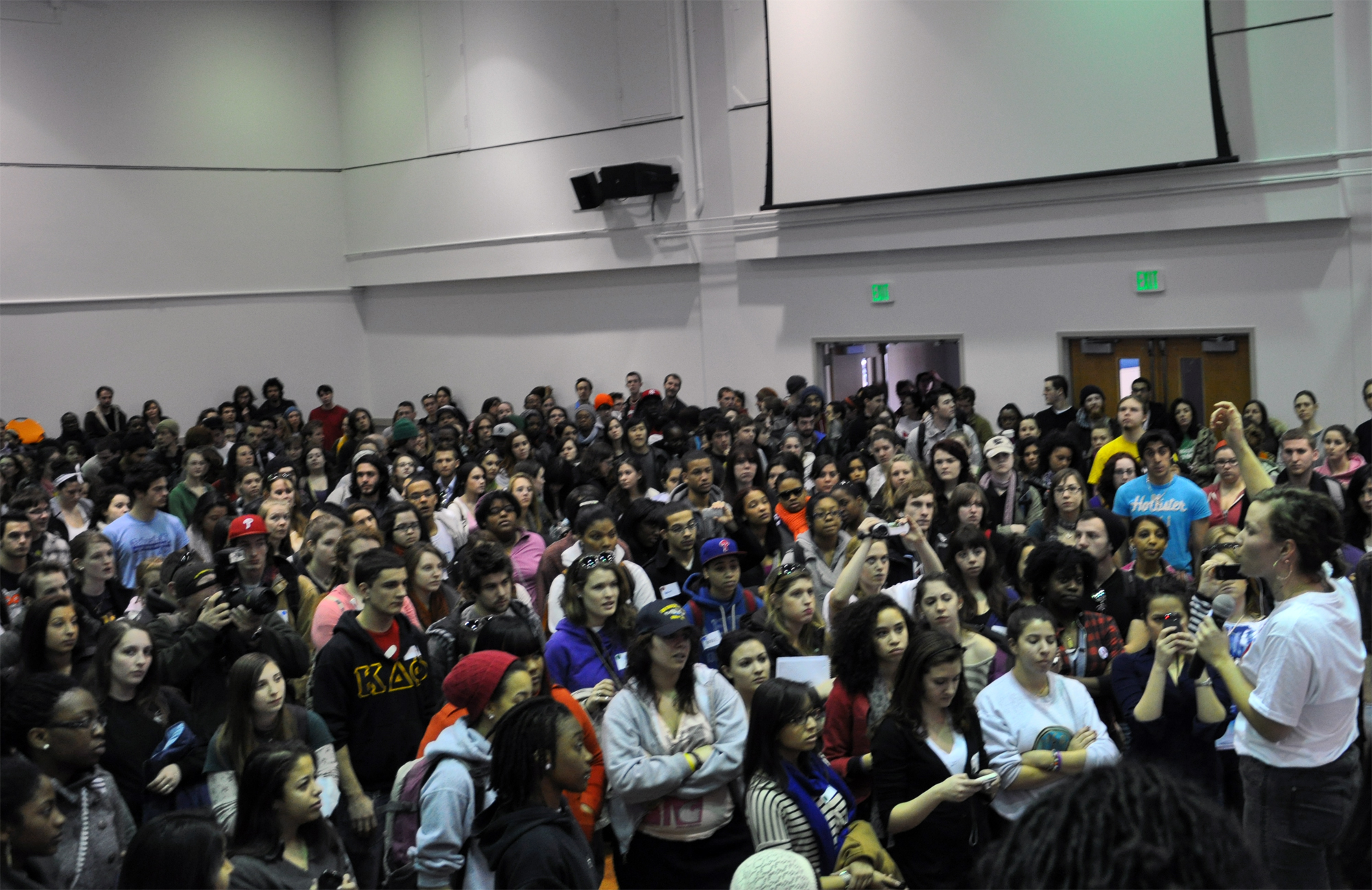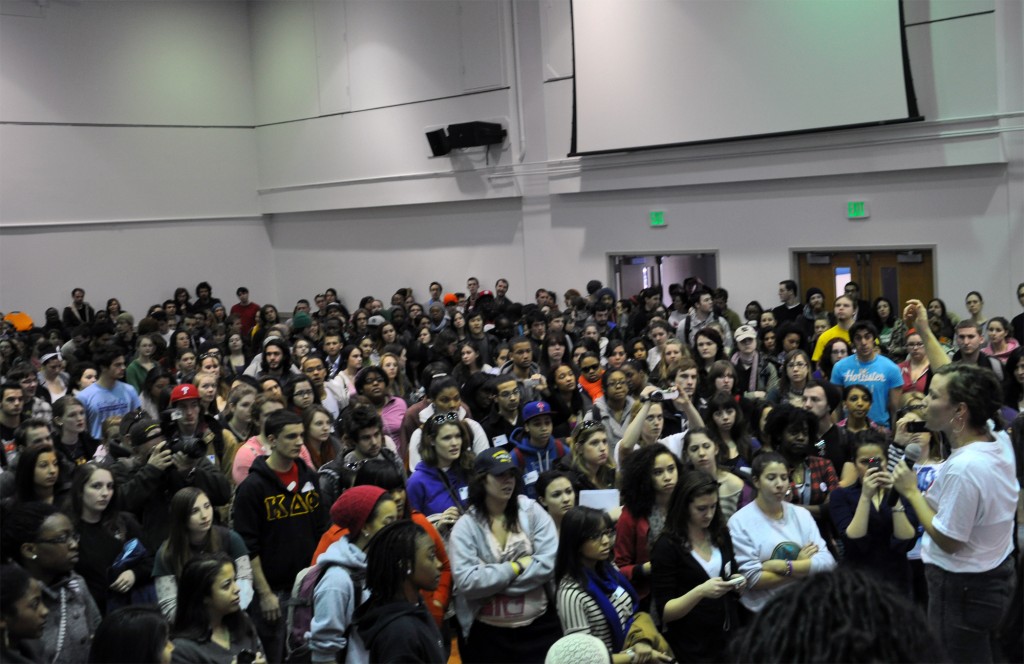

Fourth-year music and sociology major Nicholas DePalma entered the Humanities Building Tuesday afternoon with a megaphone in hand. Dozens of students filed out of lecture halls through the double-doors past him, receiving congratulations at the threshold from Student Association (SA) Vice President of Programming Anthony Lino for “caring about their education.” Standing at the end of the first-floor hallway, DePalma urged others to do the same.
“Walk out,” he said, his voice echoing off walls and closed classroom doors. “Walk out to learn how to save your favorite teachers’ jobs.”
Nearly 1,000 students left class at 12:30 p.m. on March 8 to participate in a teach-in program that organizers said was meant to provide information about school, state and national budgetary woes.
The walk out and teach-in program was facilitated by Student Association (SA) E-board members and senators, as well as participants of the Feb. 22 student-run budget forum, “The Final Cut.” About 30 to 40 organizers directed students from the Student Union Mutlipurpose Room to a series of four different workshops focused on campus, state and national budget issues and communicating with legislators and others to organize in opposition to funding cuts to educational programs.
Third-year sociology major James McGaley said he became involved in the planning for the program because he felt the student body needed to come together and discuss how the college’s multi-million dollar deficit was being handled.
“Students are catalysts for real social change,” he said. “If we don’t act now, things are only going to get worse.”
As of December 2010, SUNY New Paltz administrators were planning to economize to meet a $3.2 million deficit caused by reduced state support, contractual salary increases and other reasons, according to Interim President Donald Christian. However, Christian and Vice President of Finance and Administration Jackie DiStefano announced last week that Gov. Andrew Cuomo’s proposed budget plan includes a net reduction in state taxpayer support for SUNY campuses of 10 percent. They estimated that the proposed plan would reduce the college’s revenue by an additional $3.1 million, which would create a total deficit of $6.3 million in the core instructional budget.
Students who attended Tuesday’s teach-in said they felt the governor’s plan disregarded institutions of public higher education.
“Our programs are being threatened and that’s not alright,” said Nick Cacace, a third-year political science and sociology major. “I’m furious.”
At the beginning of the program, SA Senate Chair Terrell Coakley said students should channel their anger and make their voices heard to the New York State Legislature so that SUNY funding cuts are no longer passed. Reading a poem to a cheering crowd, he said students needed to fight for “something greater than [themselves].”
Marianne Badalamenti, a first-year education major with a concentration in Spanish, said she left class with the permission of her professor to take in what was being discussed and learn more about the budget.
“I was wondering if they had information about what’s being cut,” she said. “I also wanted to know what kind of influence students could have.”
Before the teach-in started, SA Vice President of Academic Affairs and Governance Caitlin Ryan said attendees should take the information presented to them in discussions and a student-produced booklet and formulate their own thoughts so they could educate one another.
“Some people wanted us to give them specific solutions,”said SA Executive Vice President Eve Stern. “We tried to explain that this program was organized to offer resources they could use to personalize ideas in their own way.”
Students hosting the workshops offered facts about how the core instructional budget was organized and statistics about previous SUNY funding cuts. Opinions were also shared in regards to the “lack of transparency” in the budget planning process on campus, in addition to suggestions to bring forth to state legislators and other government officials.
After a discussion that included ideas about renewing the state’s millionaire’s tax designated for residents earning over $200,000 annually and the “attack on the public sphere,” Coakley said students should appeal to government officials so they know how much they care about their education.
“We think of them as enemies, but they have families too,” he said. “They would be monsters not to empathize with us on some level.”
Sens. Samantha Kossin and Rose Faber said in another workshop that students should recognize the power that the New York State Legislature and governor have in controlling the state funds that supplement the SUNY system and also vote.
With overflow rooms filled and organizers having ran out of the 500 name tags they purchased for the day at the beginning of the event, SA President Jennifer Sanchez said she was happy with the attendance of the teach-in. She said she hopes those who could not walk out of a class for whatever reason would learn about the discussions that occurred from their friends.
Peter Brown, the vice president of academics for the United University Professions union, said he was impressed with the event and hoped his colleagues would feel similarly.
“I would hope that faculty understand that this is an historic event and that it was important for students to participate,” he said.
Although faculty members were obligated to attend their scheduled classes, some attended portions of the program. Questionable Authorities, a band composed of sociology, psychology and biology professors, played a set during the final portion of the teach-in. At this time, students also made signs for SUNY Palooza on March 15.
Sanchez said SUNY Palooza – a day which students across the system will be lobbying in Alabany, N.Y. – will now be the focusing on the organizers who will be reaching out to an e-mail list serve of teach-in attendees to keep students involved. She said there have also been discussions about involving the SUNY Student Assembly in a program and rallying in Washington, D.C. so students could express their disdain for education funding cuts.
“The need to take action was affirmed today,” she said. “Our generation has been labeled as apathetic, but if we turn down distractions, we can clearly focus our energy on social change.”
